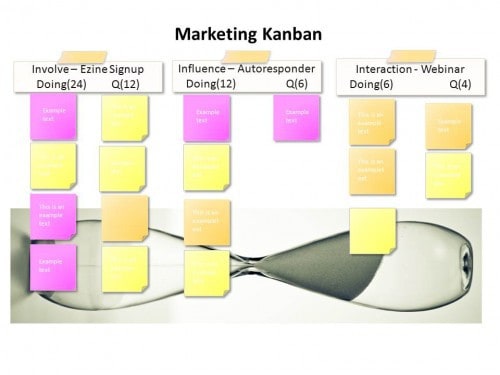 Today's guest blogger is Joe Dager, of the site Business901. He's a very active blogger and podcaster and he's very active on Twitter (@Business901) as well. Joe also takes the step of turning the podcasts inteviews into free e-books, which you can also download.
Today's guest blogger is Joe Dager, of the site Business901. He's a very active blogger and podcaster and he's very active on Twitter (@Business901) as well. Joe also takes the step of turning the podcasts inteviews into free e-books, which you can also download.
Joe interviewed me twice last year, about lean healthcare and about my use of social media.
Joe also focuses quit a bit on Lean principles applied to sales and marketing, so here is his guest post on that theme:
Don't Market without your Kanban
It is an honor and a great pleasure to have the opportunity to provide a guest post for Mark's readers and the opportunity to participate with him. Thanks Mark and keep up all the great work you do in promoting Lean.
Most people think about the marketing process as a function of lead generation and follow-up. They envision the marketing funnel which creates an excellent visual image of collecting prospects and narrowing the field till you produce a customer at the bottom. This image is often times a fair reflection of your marketing budget. You spend most of your money reaching out to the masses. It is an expensive proposition and seldom produces measurable results. However, you can't just cap the funnel because you never know where your next lead or sale will come from.
The job of marketing is to increase prospects, create better odds in obtaining a customer, and increase the number and dollars per customer. I believe marketing is also responsible for decreasing the dollars in obtaining a customer. I think these five parts can be best served through Lean and more specifically using a Marketing Kanban.
If you introduce Lean into marketing it will not take too long before you are creating a Value Stream Map of the process. Most marketing people do not look at marketing as a process so it may take a seasoned mapper to facilitate. Without drilling down too far in the process you can gather numbers of prospects in each segment and the conversion rates as they proceed through your value stream. Typically to accomplish this you must use only one marketing channel at a time or segment your list by a category. When first mapping the process, use the best defined channel so that you do not fight the process. The Value Stream Map created will be the outline for your Kanban.
Kanban has recently been used in Lean Software development as a way of limiting work in process and the amount of new work that is introduced into the process. As a result, work would be pulled from the previous stage as work is completed and levels demand. It emphasizes throughput rather than numbers. If you have read my previous posts, you would recognize the emphasis I put on throughput and the need for this to be monitored in the sales and marketing process.
I have included an example of a typical Kanban board for an internet marketing company (click for a larger view):
 I have established an abbreviated beginning and endpoint for clarity. Someone visits your website, signs up for your e-zine and is channeled to your Auto-responder that induces them to a Webinar. What makes this procedure effective is those numbers in the parenthesizes, your number of prospects that are in that particular segment of your value stream. As tasks are completed either for groups, categories or even individuals they are queued for the next stage.
I have established an abbreviated beginning and endpoint for clarity. Someone visits your website, signs up for your e-zine and is channeled to your Auto-responder that induces them to a Webinar. What makes this procedure effective is those numbers in the parenthesizes, your number of prospects that are in that particular segment of your value stream. As tasks are completed either for groups, categories or even individuals they are queued for the next stage.
Adhering to this process limits your work in a given stage. In Lean manufacturing we believe that limiting your Work in Process (WIP) is a good thing. It is also a good thing in Sales and Marketing. If you control the amount of work in your process you will respond to your prospects needs more efficiently and as a result increase throughput. Improving throughput is the quickest way to accelerate sales and as a result increase revenue.
Utilizing the Kanban provides a visual indicator to your WIP and as a result demonstrates exactly what is happening within your marketing cycle. It also allows you to visually see where your constraint is in your process (I used a horizontal hourglass to depict the constraint in the picture). At that point you can allocate resources, create divergent paths, perform triage in the preceding queue or as we would say in the Theory of Constraint world; elevate the constraint.
Don't think of Kanban as a planning tool; think about it as an execution tool. Improving your marketing process does not have to constitute wholesale changes nor increased spending. Getting more customers into your Marketing “Kanban” may not solve anything at all. Improving what you do and increasing the speed that you do it may result in an increase in sales and decrease in expenses. That's marketing!
About: Joe Dager is the president of Business901 and provides direction in areas such as Lean Sigma Marketing and Achieving Expert Status. Visit the Business901.com website for a collection of podcasts and eBooks with noted Authors, Consultants and Industry Experts in the continuous improvement arena.
Don't Market without your Kanban
Mark Graban is one of most prolific Lean leaders in the field. It is an honor and a great pleasure to have the opportunity to provide a guest post for his readers and the opportunity to participate with him. Thanks Mark and keep up all the great work you do in promoting Lean.
Most people think about the marketing process as a function of lead generation and follow-up. They envision the marketing funnel which creates an excellent visual image of collecting prospects and narrowing the field till you produce a customer at the bottom. This image is often times a fair reflection of your marketing budget. You spend most of your money reaching out to the masses. It is an expensive proposition and seldom produces measurable results. However, you can't just cap the funnel because you never know where your next lead or sale will come from.
The job of marketing is to increase prospects, create better odds in obtaining a customer, and increase the number and dollars per customer. I believe marketing is also responsible for decreasing the dollars in obtaining a customer. I think these five parts can be best served through Lean and more specifically using a Marketing Kanban.
If you introduce Lean into marketing it will not take too long before you are creating a Value Stream Map of the process. Most marketing people do not look at marketing as a process so it may take a seasoned mapper to facilitate. Without drilling down too far in the process you can gather numbers of prospects in each segment and the conversion rates as they proceed through your value stream. Typically to accomplish this you must use only one marketing channel at a time or segment your list by a category. When first mapping the process, use the best defined channel so that you do not fight the process. The Value Stream Map created will be the outline for your Kanban.
Kanban has recently been used in Lean Software development as a way of limiting work in process and the amount of new work that is introduced into the process. As a result, work would be pulled from the previous stage as work is completed and levels demand. It emphasizes throughput rather than numbers. If you have read my previous posts, you would recognize the emphasis I put on throughput and the need for this to be monitored in the sales and marketing process.
I have included an example of a typical Kanban board for an internet marketing company. I have established an abbreviated beginning and endpoint for clarity. Someone visits your website, signs up for your ezine and is channeled to your Auto-responder that induces them to a Webinar. What makes this procedure effective is those numbers in the parenthesizes, your number of prospects that are in that particular segment of your value stream. As tasks are completed either for groups, categories or even individuals they are queued for the next stage.
Adhering to this process limits your work in a given stage. In Lean manufacturing we believe that limiting your Work in Process (WIP) is a good thing. It is also a good thing in Sales and Marketing. If you control the amount of work in your process you will respond to your prospects needs more efficiently and as a result increase throughput. Improving throughput is the quickest way to accelerate sales and as a result increase revenue.
Utilizing the Kanban provides a visual indicator to your WIP and as a result demonstrates exactly what is happing within your marketing cycle. It also allows you to visually see where your constraint is in your process (I used a horizontal hourglass to depict the constraint in the picture). At that point you can allocate resources, create divergent paths, perform triage in the preceding queue or as we would say in the Theory of Constraint world; elevate the constraint.
Don't think of Kanban as a planning tool; think about it as an execution tool. Improving your marketing process does not have to constitute wholesale changes nor increased spending. Getting more customers into your Marketing “Kanban” may not solve anything at all. Improving what you do and increasing the speed that you do it may result in an increase in sales and decrease in expenses. That's marketing!
About: Joe Dager is the president of Business901 and provides direction in areas such as Lean Sigma Marketing and Achieving Expert Status. Visit the Business901.com website for a collection of podcasts and eBooks with noted Authors, Consultants and Industry Experts in the continuous improvement arena.
Please scroll down (or click) to post a comment. Connect with me on LinkedIn.
Let’s build a culture of continuous improvement and psychological safety—together. If you're a leader aiming for lasting change (not just more projects), I help organizations:
- Engage people at all levels in sustainable improvement
- Shift from fear of mistakes to learning from them
- Apply Lean thinking in practical, people-centered ways
Interested in coaching or a keynote talk? Let’s talk.
Join me for a Lean Healthcare Accelerator Trip to Japan! Learn More










Joe,
Can you explain where the kanban comes in? I understand kanban as a mechanism to pull work to a step in a process, from the proceeding step. Can you explain how the autoresponder step pulls from the ezine signup for example?
Thanks,
Rob Worth
[…] Don’t Market without your Kanban […]
[…] Don’t Market without your Kanban […]
I apologize Rob for the delay. I checked back for a couple of days and did not notice the comment, I guess.
The Kanban is about managing and placing limits on your work in process.
If you would consider the typical marketing cycle as a prospect moves from one stage to another, you imagine it as step by step process and certain events taking place within that stage. With a Kanban method you have certain trigger points for each stage or even a phase within that stage allowing one marketing effort to pull from the previous. The method would also limit the number of prospects within that cycle so that the proper amount could be managed or more importantly satisfied!
Autoresponder and Ezines seem to have unlimited numbers that can be applied to them. But as you increase those numbers, you WIP) typically conversion rates between the steps decrease as a result of appealing to a broader audience. If you conversion rates decrease for example between ezine sign-up and webinar attendance it may be a time to split the Kanban into 2 separate swim lanes (giving the customer the choice at sign-up is one way) segmenting and having a separate auto-responder for the 2 groups and even webinar.
The Marketing Kanban is simply a visual execution tool to manage your WIP. Google Marketing Kanban 101, 102, etc. for short videos of each.
[…] Don’t Market without your Kanban […]
[…] Guest Post: Don’t Market Without Your Kanban – Lean Blog (tags: kanban marketing sales) […]
Online kanban tools like LeanKit Kanban (I’m part of the LeanKit team), Agile Zen, and Kanbanery make it much easier for a team of knowledge workers (like marketing, accounting, sales, lawyers, etc.) to adopt kanban and then adapt it as they learn and evolve their processes. This is especially true for distributed teams. Combining electronic kanban with ever-cheaper large touchscreens and mobile devices gives you the best of physical kanban at the team level plus vastly more capability for enterprise kanban.
http://www.leankitkanban.com
http://www.agilezen.com
http://www.kanbanery.com
http://www.agilescout.com for more options
Introducing Kanban concept of task management in marketing is something new and I believe its going to work too. Since marketing is a process with time and tasks, there is a vast opportunity for something like this.
Comments are closed.